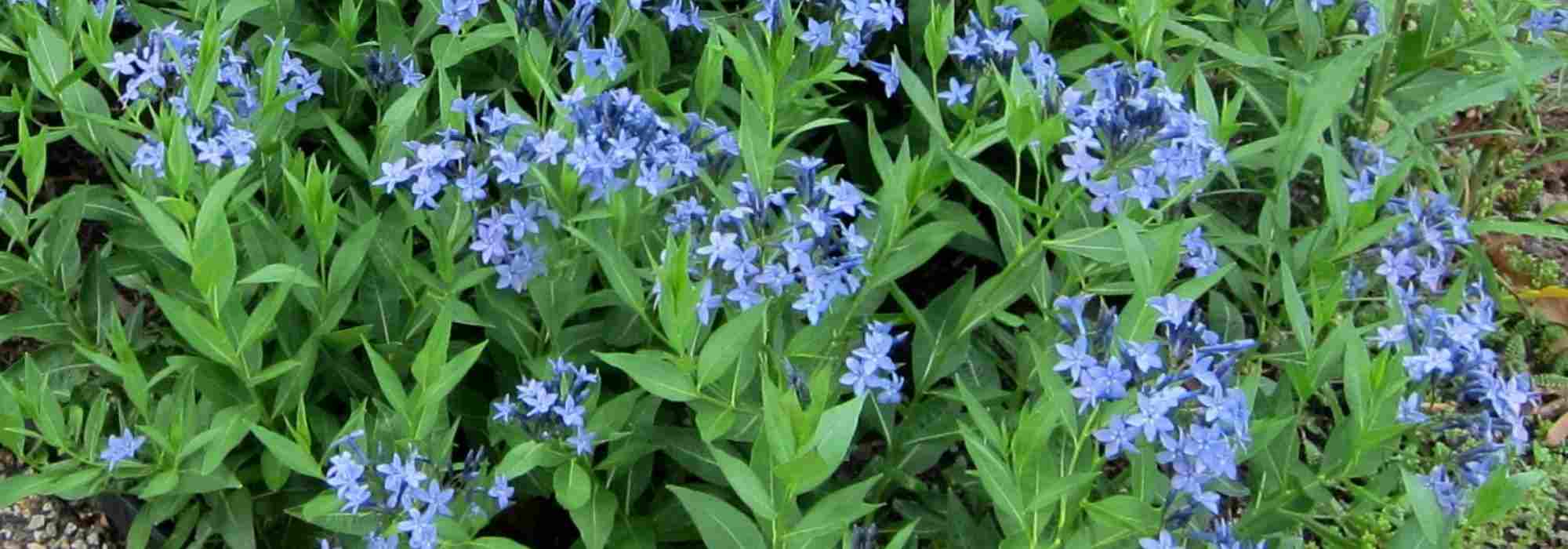
Associate Amsonia
7 ideas for combinations with blue stars
Contents
There are two groups of Amsonia: those native to America and those found in Europe at the edge of Western Asia (Greece and Turkey) known as Amsonia orientalis. The most common species native to North America, such as Amsonia hubrichtii and Amsonia tabernaemontana, are hardy perennials that withstand summer drought and heat. Their semi-woody stumps make them hardy cold-resistant plants.
Between July and September, the flower buds bloom and form a cloud of fine, elegant stars in steel-blue for some species, blue leaning more towards blue-grey or a blue with a slight pinkish hue. In any case, a flowering colour that catches the eye. Discover our 7 original pairing ideas where Amsonia shines, whether in an ornamental garden or in pots on a terrace or balcony.
To avoid any failures, we recommend planting with the help of our web application Plantfit.
In a wild garden
The Amsonia hubrichtii forms large, soft bushy clumps 80 cm high with fine, feathery foliage. Light blue flowers bloom from May to July. It takes on beautiful golden-orange autumn colours.
Caution: A summer with little sunshine weakens their vigorous growth and attenuates the autumn colours of the foliage.
Pair it with Briza media, a particularly hardy and low-maintenance grass with inflorescences resembling purple-tinted hearts to create a scene of lightness. You might choose the burnet Sanguisorba ‘Little Angel’ for colour contrast with its compact spikes adorned with raspberry-red flowers. The Verbena hastata will add verticality and highlight the rustic aspect with an exceptionally long flowering period covered in small purple flowers.
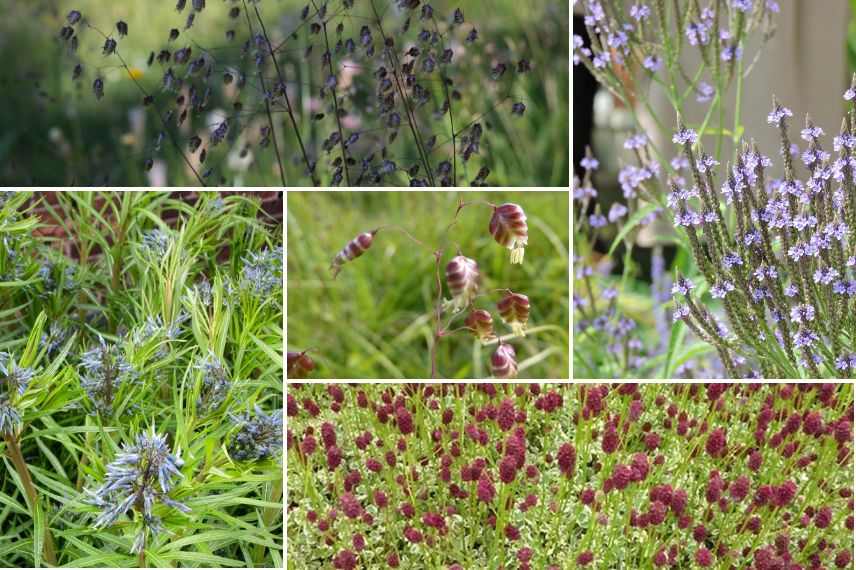 At the top, the love grass Briza media, detail of its heart-shaped inflorescence in the centre, at the bottom the burnet Sanguisorba in bloom. On the left, Amsonia hubrichtii with its fine foliage, on the right, verbena Verbena hastata.
At the top, the love grass Briza media, detail of its heart-shaped inflorescence in the centre, at the bottom the burnet Sanguisorba in bloom. On the left, Amsonia hubrichtii with its fine foliage, on the right, verbena Verbena hastata.
Read also
Amsonia, blue star: planting and careIn a soft and romantic border
The Amsonia orientalis is semi-shrubby and forms large bushy clumps nearly 1 m high over time. The blue-violet flowers appear in very open tubes grouped in panicles and abundantly bloom between July and September. The dark green, narrow lanceolate leaves with smooth edges resemble those of willow. The deciduous foliage takes on beautiful warm hues in autumn before disappearing. Hardy, the Amsonia orientalis grows easily in full sun or partial shade, in well-drained, cool soil that does not dry out in summer.
Pair it with the butter-yellow sulphur daisies of Coreopsis verticillata ‘Moonbeam’ whose very fine foliage adds lightness to the darker leaves of Amsonia. The overall softness of this scene is highlighted by the fresh butter-yellow flowering of the broom Cytisus kewensis. At the end of summer, the blue of Amsonia contrasts with the large pompom daisies of the giant echinacea or Rudbeckia maxima with long golden-yellow petals.
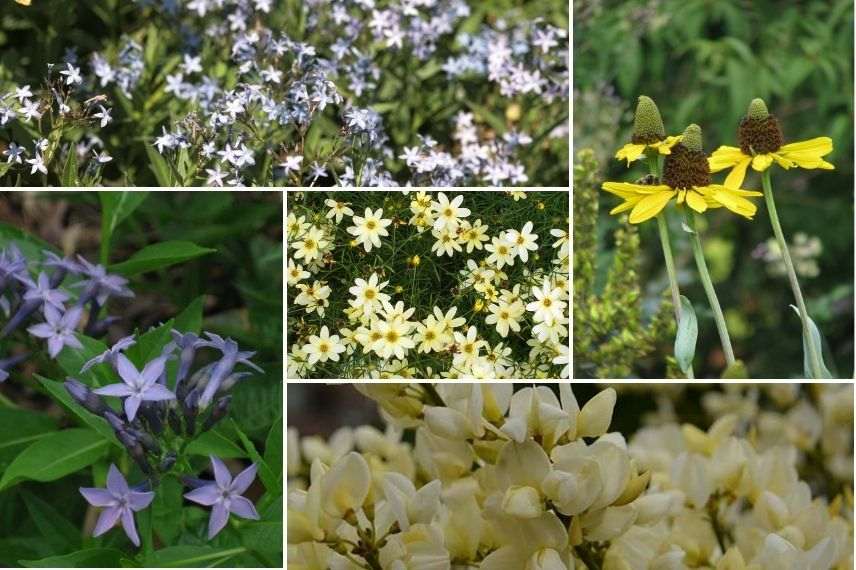
On the left, the pastel blue flowers of Amsonia orientalis and its bright green foliage. In the centre, the delicate Coreopsis ‘Moonbeam’, on the right, the majestic giant Rudbeckia. Below, the soft butter-yellow flowers of Cytisus kewensis
Discover other Amsonia
View all →Available in 3 sizes
Available in 1 sizes
Available in 1 sizes
Available in 1 sizes
Available in 1 sizes
Available in 1 sizes
Available in 1 sizes
In a late summer border
The Amsonia ciliata develops feathery foliage and numerous stems that form large, upright clumps, reaching 75 cm in height. Long buds open into small, very pale blue flowers. They are grouped in panicles and bloom between May and July.
Pair its yellow-bronze autumn foliage with that of the Heuchera villosa ‘Caramel’ which changes through the seasons, transitioning from orange and pink tones to coppery hues in autumn. From this soft and warm autumn harmony emerges the vibrant red-orange flowering of Nerine sarniensis var. corusca, or Guernsey Lily. The entire airy composition plays with the low, very yellow autumn light.

The Amsonia ciliata continues to provide aesthetic interest in late summer by donning gold. On the right, the Heuchera ‘Caramel’ and above, the Nérine sariensis corusca with scarlet flowers.
In a contemporary garden
Amsonia ciliata ‘Ernst Pagels’ develops from a woody stump several stems that gradually form a bushy clump reaching about 40 cm in height when in flower. This plant, slow to establish, lives for many years.
Its long sky-blue buds open into small lilac-blue stars, abundantly between June and July, for several weeks. The foliage of Amsonia then takes on a lovely autumn colour, bright yellow in harmony with the Tradescantia andersoniana ‘Sweet Kate’ with its golden ribbon-like foliage that displays an abundant intense blue flowering. Create contrasts with the grey-white, finely cut foliage of the arborescent wormwood Artemisia arborescens ‘Powis Castle’ combined with that of the Imperata cylindrica ‘Red Baron’ which turns blood red then burgundy as the first summer heat arrives. The Tulbaghia violacea ‘Purple Eye’ adds a touch of softness with its porcelain-fresh pink flowers.

Amsonia ciliata below, ‘Powis Castle’ wormwood above, ‘Red Baron’ Imperata in the centre, ‘Sweet Kate’ Tradescantia to the right, delicate pink flowers of Tulbaghia
In a semi-shaded border
Amsonia tabernaemontana salicifolia is a robust decorative plant with elongated leaves resembling those of willow. At the end of spring, its arching stems bear clusters of star-shaped flowers, electric blue fading to pastel as they wilt. It forms bushy clumps alongside the tall burgundy stems of Eupatorium cannabinum Plenum with soft pink heads in front of a Deutzia hybrida ‘Strawberry Fields’ known also as ‘Red Whirl’ for its abundant raspberry-pink flowering in spring.
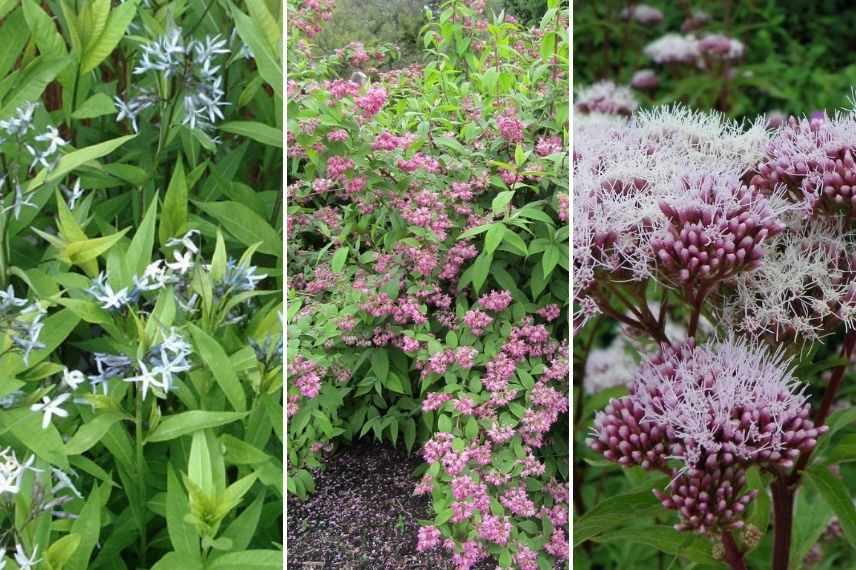
Willow-leaved amsonia and the elegant Deutzia ‘Strawberry Fields’ on the right with the inflorescences of the eupatorium
By a pond
The Amsonia tabernaemontana ‘Storm Cloud’ is a bit slow to establish, but easy to grow in full sun or partial shade, in well-drained, cool, even moist soil. It forms a large clump of unusually dark stems that bear olive green willow-like leaves veined with silver, which serve as a backdrop for the Iris sibirica ‘Ruffled Velvet’ with its numerous flowers of a magnificent blue-violet. From summer until the first frosts, Amsonia blooms in panicles of small star-shaped flowers whose celestial blue colour resembles that of periwinkles. Pair it with the Physostegia virginiana Variegata for its grey-green foliage marginate with white and its soft-coloured flowers mixed with the vivid pink of the Asclepias incarnata with a light vanilla scent.
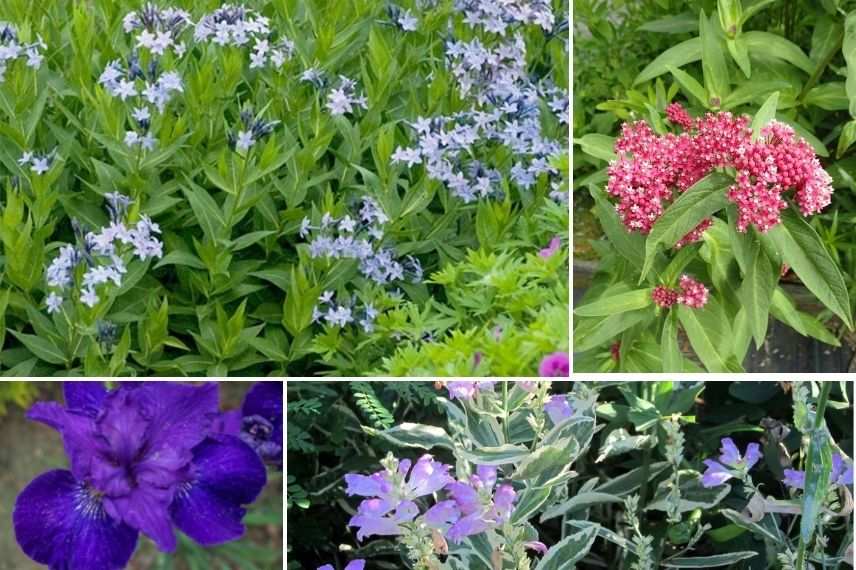
The Amsonia ‘Storm Cloud’ electric blue backdrop for the Asclepias incarnata with red flowers, and the Iris sibirica ‘Ruffled Velvet’. Below, the beautiful variegated foliage of Physostegia variegata.
In a pot on a terrace or balcony
The Amsonia tabernaemontana ‘Blue Ice’ is a hybrid that combines many qualities. The amsonia is valued for its decorative foliage throughout the season until autumn when it turns golden yellow. Its tall and bushy silhouette provides the same structural potential as a bush on a terrace. It has a long flowering period with panicles of small deep blue star-shaped flowers. Pair it with generous plants such as:
The Olearia (x) scilloniensis which, when in bloom in May-June, is covered with a multitude of small white flowers with yellow centres, resembling asters. On its side, the‘Alchemilla mollis ‘Thriller’ is a generous and decorative plant thanks to its summer flowering beautifully coloured in sulphur yellow rather than yellow-green.

The amsonia ‘Blue Ice’ with a compact habit ideal in a pot, with the Olearia scillonensis in the centre and to the right the Alchemilla ‘Thriller’
- Subscribe!
- Contents
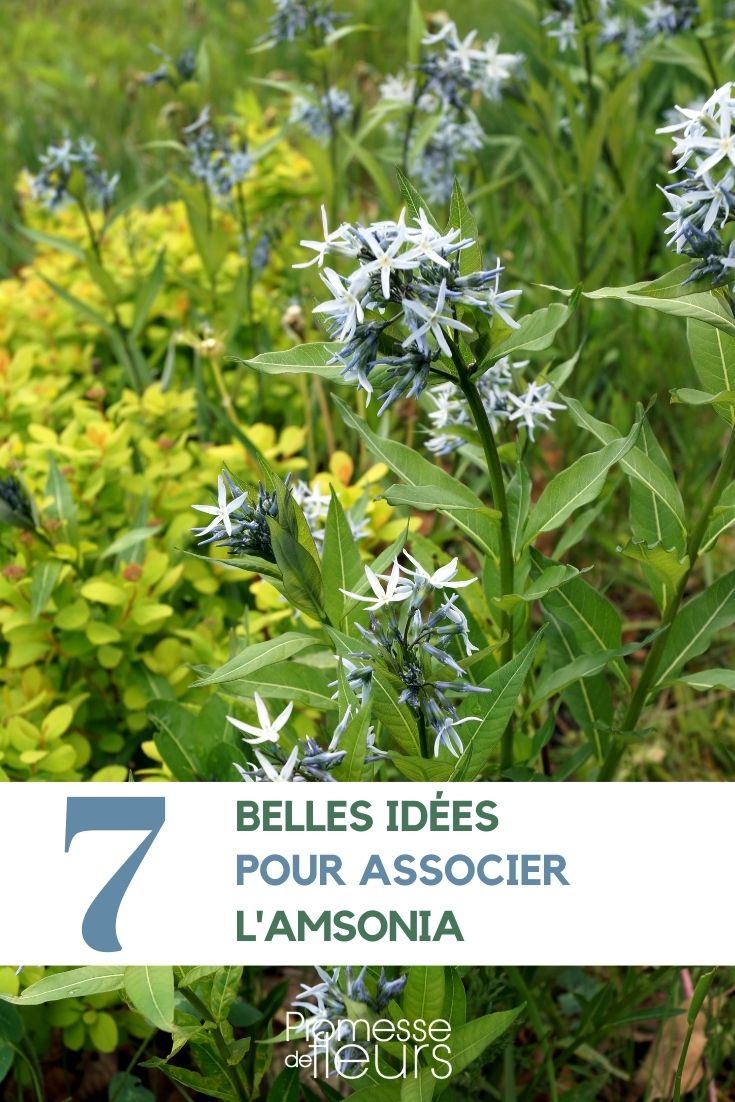































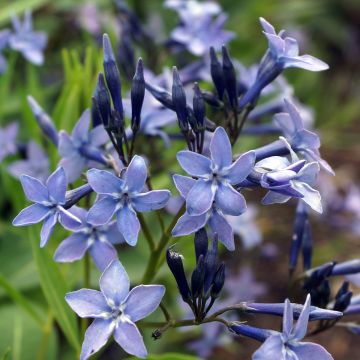





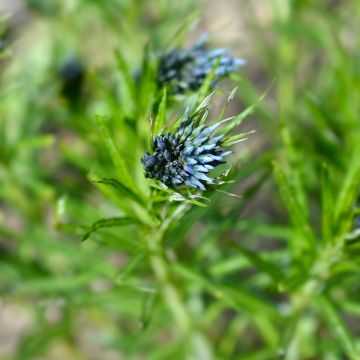
Comments